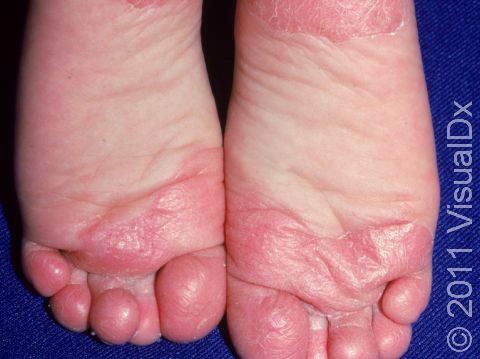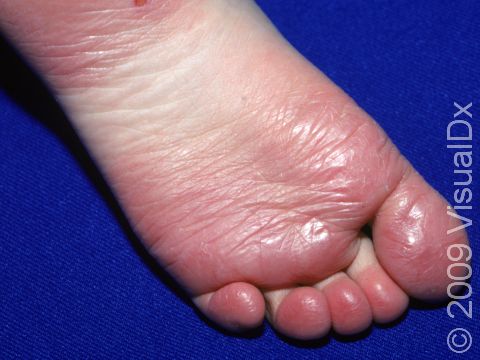Sweaty Sock Syndrome (Juvenile Plantar Dermatosis)
Sweaty sock syndrome (juvenile plantar dermatosis) is a condition where the skin becomes scaly and red on the soles of the feet of children and young teenagers.
The cause of sweaty sock syndrome is unknown, though alternating moist and dry conditions may lead to the condition. It tends to be a long-lasting (chronic) condition, lasting, on average, about 3 years. Sweaty sock syndrome usually goes away when a child reaches puberty.
Who's At Risk?
Sweaty sock syndrome occurs in children aged 3–15, but it seems to be most common in boys aged 4–8.
Children who have eczema (atopic dermatitis) seem to have a higher risk for developing sweaty sock syndrome.
Signs & Symptoms
The most common locations for sweaty sock syndrome include:
- Big toe
- Ball of the foot
- Heel
The creases between the toes (toe webs) are not usually affected.
Sweaty sock syndrome occurs as shiny, red patches on the weight-bearing surfaces of the feet. The skin appears tight and smooth. Occasionally, painful cracks (fissures) may be present. Even though children may complain of heavy sweating, the skin feels dry and scaly.
Self-Care Guidelines
If you suspect that your child has Sweaty sock syndrome, have him or her try the following:
- Wear sandals or breathable shoes.
- Avoid wearing shoes with rubber or plastic soles.
- Wear thick cotton socks and change them if they get sweaty or wet.
- Use gentle, non-soap cleansers.
- Apply greasy moisturizers, such as petroleum jelly (Vaseline®), at night.
- Apply barrier creams containing dimethicone during the day.
- Seal cracks in the skin (fissures) with liquid bandage or superglue.
Treatments
The doctor will probably check your child for a fungal infection (athlete’s foot) by scraping a small amount of surface skin (scale) and examining it under a microscope. If fungus is not seen, the doctor will probably consider the diagnosis of sweaty sock syndrome.
However, athlete’s foot is much more common than sweaty sock syndrome, so the physician may want to try a course of topical antifungal creams before concluding that your child has the later.
Once the diagnosis of sweaty sock syndrome has been confirmed, the doctor may recommend the following in addition to the self-care measures mentioned above:
- Prescription-strength topical corticosteroid (cortisone) cream
- Antihistamine pills, if itching is severe
Visit Urgency
See your child’s doctor if he or she has red, scaly feet that have not improved with self-care measures. If the child has cracks in the skin in addition to a foot rash, try to see the doctor even sooner.
Trusted Links
References
Bolognia, Jean L., ed. Dermatology, pp.224-225. New York: Mosby, 2003.
Last modified on October 10th, 2022 at 4:10 pm

Not sure what to look for?
Try our new Rash and Skin Condition Finder

